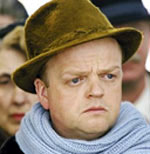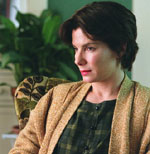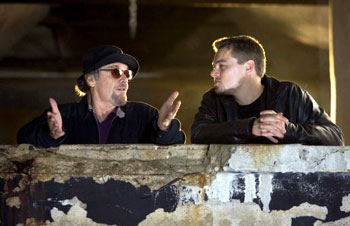|
Douglas McGrath's Infamous has pretty much reached the end of its theatrical release, only a few weeks after its opening. This is a shame, though probably guaranteed by the success of Bennett Miller's Capote, which won an Oscar for Philip Seymour Hoffman only last February. Does the world really need two movies about how Truman Capote wrote his great non-fiction novel, In Cold Blood, and how the process both made and broke him? After seeing first Capote and then Infamous, I would say the answer is yes. Capote may, in the final analysis, be the better film, but both are well worth seeing. More importantly, seeing both films gives the viewer a fuller understanding of Capote's milieu, his accomplishment, and the change that accomplishment wrought in him.
Capote was always the more obvious Oscar bait; somber and measured in tone, featuring a daring yet exquisitely nuanced performance by a wildly transformed Hoffman, Capote remained austerely focused on the creation of In Cold Blood. It stressed not only the difficulties Capote faced during (and after) the writing of the book, but also the enduring literary importance of the book itself. The scene of Capote giving his first reading from the book, before a hushed and reverent crowd, sent the Academy a message in no uncertain terms: THIS IS ART.
Seeing Infamous after Capote is like watching Auntie Mame after The Belle of Amherst. Infamous marinates us in the glitzy, gossipy Park Avenue social scene in which Capote swam like a minnow—or, as Babe Paley and Slim Keith might have said after the publication of "La Cote Basque, 1965," like a shark. If Babe and Slim appeared at all in Capote, it was in a crowd scene; in Infamous, they're front and center, played by a glammed-to-the-nines Sigourney Weaver and Hope Davis. (Bennett Cerf and Diana Vreeland are thrown in for good measure, played by Peter Bogdanovich and Juliet Stevenson.)
Infamous covers almost exactly the same ground, plotwise and historically, as Capote, but at a far higher emotional pitch. In the scenes of Capote arriving in Kansas to investigate the Clutter family's murder, Capote acknowledges that the author was a fish out of water who had to charm, wheedle and manipulate the locals into giving him the information he needed. Infamous rubs our noses in Capote's oddity, having him mistaken more than once for a woman, having him appear in ever more flamboyant costume (including one getup that can only be described as a debutante's cowgirl outfit). The higher pitch extends to Capote's relationship with the murderer Perry Smith. Whereas Capote stresses that Capote was drawn to Smith, Infamous insists flat out that Capote and Smith fell deeply in love with each other. (Infamous drives the point home by casting Daniel Craig—the new James Bond, for crying out loud!—as Smith, a far cry from Capote's physically unprepossessing Clifton Collins Jr.) Capote tells us that Capote betrayed a friend, and his own better nature, by not helping Smith with his appeals; Infamous tells us that, for the sake of his book and his literary reputation, Capote sacrificed the love of his life.
In dialogue and performances, Infamous is pretty much Capote's equal. Sandra Bullock as Harper Lee and Jeff Daniels as Alvin Dewey are fully the equals of Catherine Keener and Chris Cooper in the earlier film. And if British actor Toby Jones (a remarkable facial and physical double for Capote) lacks Hoffman's screen charisma, he makes up for it with a performance that skillfully hits every conceivable emotional note. (Jones' monologue about his mother's suicide would make stones weep.)
 
Yet, perhaps inevitably, Infamous feels slighter than Capote. Like Tru and Babe dishing the dirt at La Cote Basque, Infamous emphasizes the more salacious aspects of the story. (It also has several of the characters comment on the action in talking-head fashion throughout the movie, a distancing ploy McGrath would have best avoided.) Yet some viewers may well prefer the greater color and glitter of Infamous to the occasionally oppressive seriousness of Capote. In any case, seeing both movies gives you a remarkable cinematic portrait of Truman Capote, and how he sentenced himself to a lifetime of grief over the answered prayer called In Cold Blood. As long as you're not Gore Vidal, you should enjoy the experience.
Just as critics have been busy comparing Infamous with Capote, they have devoted much attention recently to comparing The Departed, Martin Scorsese's superb new crime drama, with his earlier films, particularly GoodFellas. A more apt point of comparison, I think, is with Mystic River, Clint Eastwood's drama of a few years ago that, like The Departed, deals with Irish cops and gangsters in South Boston.
Scorsese's film is the 'Infamous' of the two, flamboyant and operatic; Eastwood's is the 'Capote', filled from beginning to end with grim foreboding. Scorsese, believing as always that what goes around comes around, gives us a little taste of vicarious justice at the end—too little and too late, perhaps, but still it's there. Eastwood, believing that violence begets violence (a totally different principle from Scorsese's), leaves our guts ripped out with a monstrous injustice that will forever remain unavenged. After seeing both films, however, any viewer would be justified in thinking that being an Irishman from Southie is the harshest and most inexorable of fates. If you're from Southie, both Scorsese and Eastwood tell us, you will be forced to choose whether to be a lawman or an outlaw, no third choices available. But whichever you choose, they insist, you are likely to end up dying in a puddle of your own blood. The only reward for making the moral choice is the inner one, and that is small consolation indeed.
Billy Costigan (Leonardo DiCaprio) and Colin Sullivan (Matt Damon), both born in Southie under the shadow of mob kingpin Frank Costello (Jack Nicholson), had no choice in their circumstances. What matter are the choices they make as grown men, but even those are severely compromised by their surroundings. Certainly Costigan isn't given any choice: fatherly Capt. Queenan (Martin Sheen) and feral Sgt. Dignam (Mark Wahlberg) tell him the only way he'll ever be a policeman is to confess to a trumped-up charge of assault, go to jail, and on his release enlist as one of Costello's leg-breakers in order to serve as a spy for the force. Only Queenan and Dignam will know Costigan is really still a cop.

Dignam makes it excruciatingly, profanely plain that, if it were up to him alone, Costigan wouldn't even get this chance. He knows that Costigan's uncle was one of Costello's top goons; that Costigan's mother was a lace-curtain type from the hoity-toity North Shore; and that Costigan himself has a record of violence. To Dignam, that spells L-O-S-E-R. Costigan glowers at Dignam's insults, grits his teeth, and accepts the offer.
What Queenan and Dignam don't know, however, is that Costello has been busy creating his own spies. Upright, clean-cut Det. Sullivan, rising through the department's ranks like a warm knife through a block of Irish creamery butter, has in fact been raised from childhood to be Costello's mole.
Most of what follows in William Monahan's screenplay (based on the Hong Kong-made thriller Infernal Affairs) is an exercise in suspenseful, often blood-spattered frustration, laced with multiple double-crosses, cat-and-mouse chase scenes, and over-the-top violence. The audience knows from the beginning that Costigan is the good guy, Sullivan the bad one. Costigan grows ever more sympathetic (though also more strung out emotionally) as the film progresses, and Sullivan ever more hateful (eventually even exceeding Costello in villainy). Of course, the treatment the two men receive is in inverse proportion to their worth. While Sullivan gets regular promotions from his clueless boss (Alec Baldwin) and dines luxuriously with his psychiatrist girlfriend Madolyn (Vera Farmiga), Costigan gets beaten with his own boot on his already broken hand by an enraged Costello.
Inevitably, the lives of Costigan and Sullivan (who meet only toward the end of the film) start doubling back ironically on each other. Whereas Costello comes increasingly to trust and confide in Costigan, Sullivan's boss appoints him head of a task force to (what else?) discover the identity of a suspected Costello mole in the PD. Meanwhile, Madolyn, who offers counseling to recent parolees as well as to policemen, gains Costigan as a patient and notices in him a certain, shall we say, genuine quality she finds lacking in Sullivan.
It gives away nothing to say that the story ends with a body count rivaling the goriest Elizabethan revenge tragedy. Don't expect to leave the theater feeling happy, or to see all the loose ends tied. (The aforementioned taste of justice at the end—though more than Eastwood would have given us—is very little.) Do expect to feel exhilarated, however, at seeing the most satisfying film in years by one of the world's greatest filmmakers. Aided by his frequent collaborators, cinematographer Michael Ballhaus and editor Thelma Schoonmaker, Scorsese unleashes a veritable encyclopedia of cinematic tropes and quotations on the audience, even at one point stealing directly from Carol Reed and The Third Man. But, like Mozart unleashing all the different methods of counterpoint in the final movement of the Jupiter Symphony, Scorsese uses his mastery of cinematic forms to enhance the work and heighten its impact.
Also intensifying the story is one of the finest casts assembled for any movie in the past decade. Nicholson and DiCaprio, having the showiest roles, dominate the film. Nicholson, charismatic and obscenely witty, proves himself once again the great living master of gleeful movie sadism. (To see Nicholson daintily remove the gold wedding ring from a severed hand is to learn a whole new definition of the word "aplomb.") DiCaprio, manlier and beefier than in any of his previous films, gives an unforgettable portrait of a good but deeply flawed man trapped in an untenable position, with virtually no one he can call a friend. (Perhaps readers will groan at seeing the dreaded comparative word "Brando," but that's precisely the word that will come to mind when DiCaprio stares out from the screen as if trying to melt the celluloid.)
There is comparably excellent work from Damon (even wormier here than in The Talented Mr. Ripley), Sheen, Baldwin, Farmiga, and a plethora of fine actors in smaller roles such as Ray Winstone, Anthony Anderson, and James Badge Dale. Deserving special mention is Wahlberg, one of the most underrated actors in Hollywood, as well as the character he plays, Sgt. Dignam. For my money, Dignam is the most interesting character in the movie. I once read an article that said a real cop believes there are two types of people: cops and scum. Dignam refines this further—for him there are three types of people: himself, his boss Capt. Queenan, and scum. Dignam continues to goad, hassle and threaten Costigan, long after Costigan has proven his loyalty and value to the force. (However, when Costigan finally loses patience and lunges at Dignam, Dignam doesn't fight back. Is Dignam tacitly acknowledging he's finally gone too far, or playing the victim to prove that Costigan is truly untrustworthy?) Dignam also has no respect at all for Baldwin's character, and saves his most withering disdain for the golden boy Sullivan, accurately nosing out a rat when no one else can, not even Queenan. Dignam—and Wahlberg—are worth a movie of their own. Perhaps from my lips to Scorsese's ear?
|
